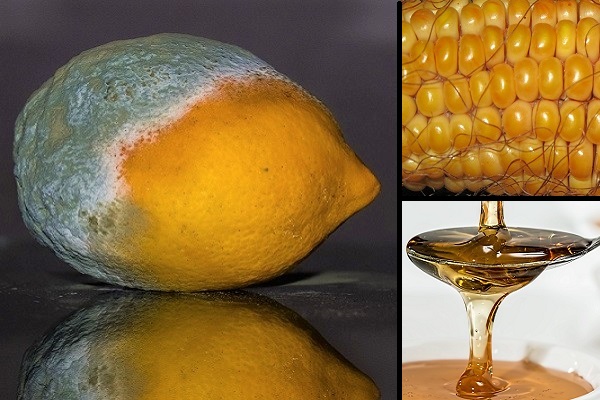When avoiding foods and supplements made from genetically modified organisms and artificial additives, it is easy to identify the big threats: corn and soy products that are not organic or non-GMO certified, and many well-known toxic chemicals. The frustration rises when realizing how many hidden ingredients are in these products that can be GMO without knowledge of their presence.
One very common ingredient to be aware of is citric acid. It is often used as a preservative, and as an additive to make soft drinks and candy taste sour. While not the same thing as ascorbic acid or vitamin C, it comes from the same sources in nature and has its benefits. When absorbed naturally from fruits, in particular citrus fruits, the body can use it as an antioxidant.
However, the issue arises when citric acid is manufactured on a large scale by a company that is not aware or does not care about the health implications of the process. The truth is, it is often too costly for the company to use natural sources such as citric fruits to produce citric acids. Instead, ingredients may be used that are GMO and contain a fermented mold. Both of which may be one of the reasons why some people have a citric acid intolerance.
Manufacturing Synthetic Citric Acid Involves GMOs
While citric acid can be derived naturally from citrus fruits, the process is considered to be expensive, so the manufacturers found a synthetic and potentially toxic process instead. Most of citric acid found in commercial foods and products (under the name E330) today is created by a chemical reaction: simple carbohydrates (sugars) are being fed to Aspergillus niger mold, which then goes through fermentation. The resulting substances are processed and synthetic citric acid is born.
“We would all love to think that citric acid comes from an orange, but it does not. It comes from a chemical process,” said Dr. Mary Mulry, a food scientist of FoodWise, who thrives to create better food options for people.
If commercial citric acid does not come from citrus fruits, what are its strange-sounding ingredients?
Aspergillus niger mold is not the deadliest Aspergillus fumigatus, but it is its cousin. Aspergillus niger grows on dead matter and decay, and when inhaled, its toxins weakens the immune system and can cause sickness and even death. It often causes allergic reactions, which might partly explain the allergy to citric acid. Aspergillus niger would be particularly dangerous for those whose immune system is already weakened by leukemia, HIV, AIDS, or exiting fungal allergies. On rare occasions, it can cause severe reactions in completely healthy individuals as well: a serious ear infection called otomycosis can be caused by this fungus, as well as a severe allergic reaction or an asthma attack.
Organic Crop Improvement Association also pointed out that A. niger may be a GMO product itself.
The manufacturing industry, whoever, loves A. niger and considers it to be very useful to production of many products. Besides making citric acid, it is commonly used in the production of corn syrup.
Speaking of corn syrup, it is the cheapest simple carbohydrate to use for citric acid. Cheap corn glucose syrup (commonly GMO) is fed to A. niger mold to create citric acid.
Needless to say, mold and GMOs are not what many of us had in mind when we were thinking of citric acid.
More than 1.6 million tons of this additive is produced in the U.S. alone, every single year. It is manufactured by Pfizer, a biopharmaceutical giant once allied with Monsanto, as well as Archer Daniels Midland Co. and Cargill.

Citric acid is found in a growing number of products:
-Drinks: soda, juices, and wines
-Snacks and candies
-Diet and nutritional products
-Supplements
-Pharmaceuticals
-Cosmetics
-Household cleaners, detergents
-Frozen foods
-Sauces and seasonings
-Dairy products and ice creams
-Pet food
-Soups
-Canned food
-Breakfast food items
There are many “natural” products that contain synthetic citric acid, unfortunately.
There have been a few lawsuits against companies who claim to be natural but use citric acids, such as a lawsuit against Jamba Juice in California in 2012. Another lawsuit was filed against AriZona beverages, but the judge would not hear it.
Citric Acid Intolerance: Symptoms and Explanations
There is a growing concern that traces of mold in citric acid can trigger mold allergies. You will find many personal stories of people online who have an A. niger allergy, which has been confirmed by doctors and allergy tests.
Citric acid allergy symptoms include:
-Itching
-Tingling
-Inflammation
-Digestive issues
-Cramps
-Stomach pain
-Vomiting
-Anaphylactic shock
-Nausea
If you have allergy symptoms to natural citric acid, it is probably not mold related. But if you are fine eating oranges, but synthetic citric acid in commercial product cause issues, you may want to take an A. niger allergy test.
Organic Materials Review Institute (OMRI) says that the use of GMO fungus (A. niger) to create citric acid is “unacceptable.”
The mainstream scientific community is skeptical. They have documented cases of citric acid sensitivity, but do not want to attribute it to mold. Same researchers, however, do raise a concern that is made from a GMO material. The industry has finally started to create some non-GMO citric acid products.
Natural Citric Acid: Foods and Benefits
Meanwhile, when getting citric acid from natural sources it acts as an antioxidant and fights free radicals, and can be beneficial for the body. It helps decrease acidity level and acts as alkalizing agent. It prevents bacteria from thriving and reproducing. It also allows excess calcium to leave the body, while improving mineral absorption.
Getting natural citric acid from food is easy when consuming:
-Limes, oranges, and grapefruits
-Kiwis
-Strawberries, raspberries, and cherries
-Apples and pears
-Mushrooms
-Potatoes
-Tomatoes
-Peas
-Asparagus
Too much of it, however, can lead to stomach upset, bloody stools, low blood pressure and dizziness, and hair damage.
It is much harder to get too much of a natural nutrient from food, as the body will get rid of the excess. However, citric acid in commercial foods and supplements may be too much for some people, especially when derived from GMO sources.
Finding Non-GMO Citric Acid
When buying processed food and supplements make sure they are organic or non-GMO certified.
The most transparent companies will say on the label if the citric acid is derived from citrus fruits, or if it is non-GMO.
When buying pure citric acid for cooking, cleaning, and crafting uses, look for a non-GMO product and read the label to see what it is derived from (such as cane sugar).
Pure citric acid has numerous household uses.
In cooking, it can be used as a flavor enhancer in pies, candy, and other desserts. It can be used as a preservative in meats and vegetables. It can also act as a great cleaning agents to get the gunk out of coffee pots, shower heads, and dishwashers. It can be used to make a homemade detergent.
As long as you know the source and quality of citric acid, it has been proven to be quite beneficial. But it’s best to avoid unmarked citric acid, which just may come from GMO mold and corn.







